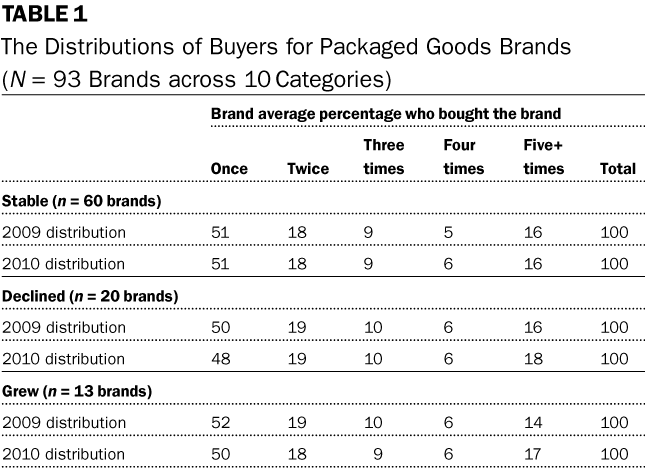Ehrenberg-Bass Institute, University of South Australia
Have you ever felt overlooked, neglected, and ignored, even though you make an important contribution?
Let me introduce you to the light buyer, someone who feels the same way. Heavy buyers are the darlings of the marketing world. Everybody loves them: They buy lots, they usually know all about the brand, they join our Facebook pages, and they even speak well of the brand in surveys. Many of our marketing activities—loyalty programs, for instance—are designed to appeal to them (Wansink and Park, 2000; Sharp, 2010). If we could, we would clone them.
Has this adoration of heavy buyers blinded us to who is really fueling our brands’ market share? Even though light buyers buy only once or twice in a year, examine most packaged-goods brands’ customer base and you will find that these light buyers make up a large, if not the largest, segment of buyers.
The more statistically minded will point to the negative binomial distribution, which describes and predicts a brand’s purchase-frequency distribution (Ehrenberg, 1959). This predicts that any purchase-frequency distribution in a year will typically favor light buyers as the largest segment. For those who like to see data, let us look at some actual numbers that underpin the customer base of brands, year on year.
METHODOLOGY
A total of 93 brands across 10 categories from Kantar Worldwide’s U.K. household panel were analyzed. The categories covered a range of personal, household, food, beverage, and snack items: toothpaste, shampoo, laundry detergent, deodorant, tea, instant coffee, everyday biscuits, crisps and snacks, breakfast cereal, and yellow fats.
I looked at the purchase frequency distributions across all customers in 2009 and then again in 2010. I also split brands into three categories based on change in market share from 2009 to 2010:
- Growth = increased market share by 0.5 percentage points (pp) or greater;
- Decline = decreased market share by 0.5pp or more; and
- Stable = if market share changed by less than +/– 0.5pp.
The results showed that once- (and twice-) only buyers made up the vast majority of people who bought a brand (See Table 1). This distribution was consistent for each year and was irrespective of whether the brand grew, declined, or was stable.

This consistent distribution leads to a simple conclusion: brands predominantly grow by changing the size—not the nature—of their customer base. When a brand grows, it gains more customers. This gain, however, is largely in line with the distribution of customers it had last year. And this means that most of the buyers gained or lost will be light brand buyers.
In practical terms, this distribution means a large proportion of buyers move from zero-to-one purchase and from one-to-zero purchases year on year.
Put yourself in the place of these buyers for a moment. Yes, they may have bought/not bought a brand that year, but that one new purchase hardly is a life-changing event. Indeed, I wonder how many of them actually noticed it happened. Although this purchase is a small part of the life of these buyers, however, the combined contribution of these purchases is vitally important for brand (Anschuetz, 2002). Isn’t it time that our research efforts reflected the importance of the light and non-buyer of brands?
In particular, I would like to focus on consumer-based brand equity research (as per Keller, 1993). Most of the new brand-equity concepts developed and tested in this area aim at influencing or developing heavy brand buyers. These concepts encourage marketers to focus on building commitment, advocacy, and/or passion for the brand. Very little is concerned with the light buyer; even less considers the equity of non-users. And how are we to develop models that predict brand growth without understanding the brand’s largest current and potential buyer segments?
To focus on light/non-buyers means taking a different research path. We cannot assume, for example, that the act of purchasing a new brand always is a deliberate decision driven by strong feelings toward the new brand.
Take the case of a consumer who goes from not buying at all to buying a brand five times a year. I can believe that this consumer actually is aware of this change in behavior and may be able to articulate some reason for the new pattern of purchases.
However, when we contemplate the move from zero-to-one purchase, we need to consider the nonconscious forces or environmental circumstances that may have played a role. We also need to be careful not to over-interpret the drivers of an observed purchase in any time period. Someone who did not buy a brand last year but makes a purchase this year may be someone with a very low propensity to buy emerging in the time period. Our marketing may have played a role in triggering this behavior, but separating out real change in behavior from stochastic wobble is a difficult task. Our increasingly large databases of customers and the activities they are exposed to, however, may help achieve this…. if we employ them smartly.
Some critical questions include the following:
- What proportion of light buyers cease to purchase in any year due to forgetting, distribution shortfalls, or lack of salience versus a conscious decision to switch brands?
- What proportion of buyers who buy a brand for the first time in any year do so as a conscious decision to trial a new brand? What proportion is in-store circumstance?
- Do the marketing activities that affect heavy buyers also reach and impact light buyers? Or do we need a different set of activities to reach and have an effect on this segment?
- What sort of changes in buyer memory structures might cause someone to become a light buyer of a brand? Are they different from those who cause someone to become a heavy buyer? Or is it a continuum of effects?
The answers to these questions will help us understand the role of advertising in driving sales from this segment as opposed to in-store activities.
For those involved in tracking brand equity, there also are a few questions that can add to current knowledge of light/non-buyers:
- Can you identify light buyers and non-buyers in your surveys?
Research from the Ehrenberg-Bass Institute found that the largest error in self-reported brand-usage metrics is that once-only buyers forget that one purchase. We need to improve our questions to accurately capture the full spectrum of brand-buying behavior. Brand buying/usage sections of trackers often are poorly designed and, therefore, are not very well regarded by researchers. We need this to change.
- Do you ask questions that a non-buyer of the brand can answer?
Researchers’ prior focus on heavy buyers means that many of our brand-equity questions implicitly exclude a brand’s non-buyers. For example, asking buyers to a make strong evaluation such as “best brand at nourishing hair” leads most people to answer for the brand they buy most often rather than brands they buy infrequently or not at all (the wording implies only one response needed).
Non-/light buyers of your brand in any time period also are buyers of other brands. A question with skewed wording can lead them to respond in favor of the competitor they know well, at the expense of learning about their thoughts on your brand. Such questions limit the type of brand equity information you collect. This makes it difficult to identify when these non-buyers might begin to consider your brand.
- Do you report on metrics from buyers and non-buyers separately?
There is a long history of research showing that buyers/users of brand respond systematically higher to brand-related questions than non-buyers/users (Bird, Channoon, and Ehrenberg, 1970; Romaniuk and Wight, 2009). Aggregation makes it harder to see the (most likely) small changes in the brand perceptions of those about to undergo a transition from a non-buyer to a light buyer (or vice versa).
Most of the brand-buying activity by most brand buyers is a small, relatively insignificant part of their life. Light buyers are often the largest part of a customer base and a large part of any representative research sample but only a small part of the responses that are captured about any one brand in most brand equity surveys. This makes it easy to miss the signals from this segment. Researchers need to make sure light and non-buyers have the opportunity to express their thoughts and feelings. And we must be every bit as sure that we give ourselves a chance to listen to what this segment has to say. This may open our eyes to the real impact of marketing activities in supporting and growing a brand.
References
Anschuetz, N. “Why a Brand’s Most Valuable Customer Is the Next One It Adds.” Journal Of Advertising Research 42 (2002): 15–21.
Bird, M., C. Channon, and A. S. C. Ehrenberg. “Brand Image and Brand Usage.” Journal Of Marketing Research 7 (1970): 307–314.
Ehrenberg, A. S. C. “The Pattern of Consumer Purchases.” Applied Statistics 8 (1959): 26–41.
Keller, K. L. “Conceptualizing, Measuring, and Managing Customer-Based Brand Equity.” The Journal of Marketing 57 (1993): 1–22.
Romaniuk, J., and S. Wight. “The Influence of Brand Usage on Responses to Advertising Awareness Measures.”International Journal of Market Research 51 (2009): 203–218.
Sharp, B. How Brands Grow. South Melbourne: Oxford University Press, 2010.
Wansink, B., and S. B. Park. “Methods and Measures That Profile Heavy Users.” Journal Of Advertising Research 40 (2000): 61–72.
About the author
Jenni Romaniuk is associate professor of brand equity and associate director (international), Ehrenberg-Bass Institute for Marketing Science, where her research focuses on brand equity, advertising effectiveness, and word-of-mouth. In addition to the Journal of Advertising Research, her work has been featured in the pages of the Journal of Business Research, theJournal of Marketing Management, Marketing Theory, the European Journal of Marketing, and the International Journal of Market Research. Email: Jenni.Romaniuk@Marketingscience.info

 QRCA is a not-for-profit association of consultants involved in the design and implementation of qualitative research — focus groups, in-depth interviews, in-context and observational research, and more.
QRCA is a not-for-profit association of consultants involved in the design and implementation of qualitative research — focus groups, in-depth interviews, in-context and observational research, and more.